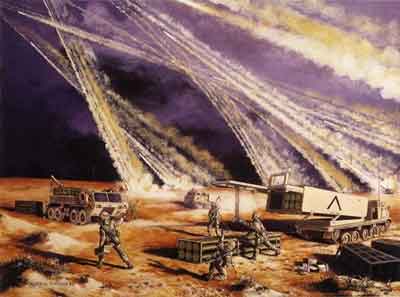Steel Rain

An analysis of Cluster Bomb use by the
US in four recent campaigns
by Marc W. Herold
Departments of Economics and Women's Studies
Whittemore School of Business & Economics
University of New Hampshire
POSTED JUNE 16, 2003 --
Terrorized Iraqi troops in 1991 called exploding US cluster bombs 'steel rain.'1 Such cluster munitions can either be dropped from aircraft or fired inside artillery shells. The 'parent' bomb breaks apart as it nears the ground, spewing forth sub-munitions [or, bomblets]. The widely-used CBU-87 1,000 pound cluster bomb leaves a footprint of 458 meters; its wind-corrected version, the CBU-103, has a footprint of 183 meters. The footprint is measured by the area covered by bomblets. Each bomblet [BLU-107] in the CBU-87 injures people in a 152 meter radius. The bomblets drift down to earth with a small parachute. Though most explode upon impact, many do not. The reported 'dud rate' varies from eight – 22 percent.
Another cluster bomb, the CBU-105, is a 1,000 pound wind-corrected version that was first used on April 2, 2003, when a B-52 dropped six of them on "an Iraqi tank column heading south out of Baghdad." The CBU-105 contains 40 'SADARM' bomblets. Incredibly, each has its own radar, and has a killing footprint of 150x360 meters.
The following Table presents a summary of cluster bombs used in four of the seven military campaigns where the US has employed this weapon. I have omitted Laos, Cambodia, Vietnam. The impact that emerges is that in Kosovo, Afghanistan2, and the recent Iraq campaign, similar amounts of cluster bombs have been dropped, leaving a deadly legacy of about 30-35,000 unexploded bomblets in each country’s fields and neighborhoods.
Table.
Air-delivered* Cluster Munitions in Recent Anglo-American Military Campaigns
| Campaign | Weapon | Bomblets per bomb | Cluster Bombs dropped | Bomblets delivered | Dud rate range | UXO bomblets | |
| Gulf War, 1991 | CBU-87 | 202 | 61-80,000 | 24-30 million | 5-8% | 1.2-1.5 million | |
| CBU-89 | 99 | ||||||
| Rockeye Mark 20 | 247 | ||||||
| NATO/Kosovo, 1998 | RBL-755 | 147 | ~1,700 | 290,000 | 8-12% | ~35,000 | |
| CBU-87 | 202 | ||||||
| CBU-97 | 10 | ||||||
| Afghanistan, 2001-2 | CBU-87 | 202 | 1,210 | 244,000 | 10-22% [est. 12%] | ~30,000 | |
| CBU-103 | 202 | ||||||
| CBU-89? | 99 | ||||||
| CBU-99 Mark 20 |
247 | ||||||
| AGM-154 | 145 | ||||||
| IRAQ II, 2003 | CBU-87 | 202 | 1,461 | 270,411 | 10-15% [est. 12%] | 32,500 | |
| CBU-99 | 247 | ||||||
| CBU-103 | 202 | ||||||
| CBU-105 | 40 | ||||||
| CBU-107 | ** | ||||||
| AGM-154 | 145 | ||||||
Note: The first row for each campaign contains the cumulative totals for all cluster munitions.
* Omits ground-launched cluster munitions, as for example: the Multiple-Land-Rocket System [MRLS] which contains 12 M26 missiles [each carrying 644 cluster bomblets]; The Army Tactical Missile System [ATACMS] with a surface-to-surface missile carrying 950 bomblets; The British L20 artillery shell [containing 49 bomblets], etc.
** The CBU-107 first used in Iraq in 2003, emits a high-speed volley of more than 3,000 metal arrows, projected from a single cannister. Two were used in Iraq.
Sources: Available from the author upon request.
-- 30 --
Footnotes
1. Peter Walker, "Cluster Bombs Too Effective for Military To Do Without: Expert," Agence France-Presse [April 3, 2003]
2. For details on cluster bombs in Afghanistan, see my "Above the Law and Below Morality: Data on 11 Weeks of U.S. Cluster Bombing of Afghanistan".
